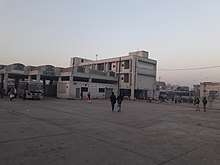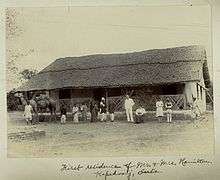Kapadvanj
| Kapadwanj | |
|---|---|
| Town | |
 Kapadwanj Location in Gujarat, India  Kapadwanj Kapadwanj (India) | |
| Coordinates: 23°01′N 73°04′E / 23.02°N 73.07°ECoordinates: 23°01′N 73°04′E / 23.02°N 73.07°E | |
| Country |
|
| State | Gujarat |
| District | Kheda |
| Elevation | 69 m (226 ft) |
| Population (2001) | |
| • Total | 61,209 |
| Languages | |
| • Official | Gujarati, English |
| Time zone | UTC+5:30 (IST) |
| PIN | 387620[1] |
| Vehicle registration | GJ 07 |
| Website |
kapadvanj |
Kapadwanj (Karpat – Vanjiyam or "The Land of Textile") is a town as well as one of the Taluka of the Kheda district in the Gujarat India. It is located on bank of river Mohar. It is 71 km away from Ahmedabad and 93 km away from Vadodara.
Geography

Kapadvanj is located at 23°01′N 73°04′E / 23.02°N 73.07°E.[2] It has an average elevation of 69 metres (226 feet).
Climate
Kapadvanj usually experiences a semi-arid climate. The temperatures shoot up to 45-47 degree Celsius especially in the month of May. Hot winds blow over the region known as"Loo". Rainy season starts from July and ends in September. Rainfall is between 750-800mm. In winters temperature fall to 8-9 degree Celsius. Mild climate causes pleasant weather during the season
History, Historical Places

Jayasimha Siddharaja (1094 – 1143), Chaulukya king, built some of Gujarat’s finest architectural structures. He had built two exquisite Vavs (step wells) and a Torana at the centre of the old town. The main structure called kundvav is a rectangular structure, similar to plan of Modhera Sun Temple step well. However, it is smaller and simpler than Modhera’s.
Kapadvanj was a major trading centre on the route inland from the port of Cambay and trade brought it wealth and importance in the time Siddharaj Jayasinh. As it was located close to Mohar River, it was a perfect place for constructing step wells for water supply. According to local historians and elderly folks the town had five gates. The torana at Kapadvanj is one among the 13 kirtistambhas in Gujarat; however it is amongst the best preserved, only after the Vadnagar torana. It has two pillars and a transverse architrave. The entire torana is covered with elaborate sculptures.
Other historical place of Kapadwanj is Vohrawad (a Bohra neighbourhood marked by the special character of the elegantly hybrid architecture). There are few wooden havelis there. They wore even sculptures of musicians, a usual feature of pol wooden houses in Ahmedabad.[3]
There are nine Jain Temples in Kapadvanj. Chintamani Parshwanath Temple, Astapad Temple, Glass temple of Shantinath are famous of them.
Feroze Tuglaq Mosque in Kapadwanj has a unique calligraphy originated in Gujarat called Khat-e-Bahaar which blends local elements in Arabic script.[4]
Demographics

At the 2001 India census,[5] Kapadwanj had a population of 90,921. Males constituted 52% of the population and females 48%. Kapadwanj had an average literacy rate of 73%, higher than the national average of 59.5%: male literacy was 79%, and female literacy 67%. In the city 12% of the population were under 6 years of age.
When Gujarat separated from Mumbai, the government created 10 dist and 40 taluka, Kapadwanj was one of them. Kapadvanj was a Lok Sabha parliamentary constituency in Gujarat. Shankarsinh Vaghela was last MP from Kapadvanj.
Education
Kapadvanj has many educational institutions like Maneklal Desai Kishor Mandir, Shree L M Sharda Mandir School, M P High School, Shree Ganesh English Medium School, School for success(jeevanshilp campus), Shree C.N.Vidyalaya, Knowledge High School [6] Parekh Brothers Science College , V.M Parekh and K.S. Shah Arts and commerce college.
References
- ↑ "Kapadwanj PinCode". citypincode.in. Retrieved 2014-05-19.
- ↑ Falling Rain Genomics, Inc - Kapadvanj
- ↑ http://jitumisra.wordpress.com/2013/10/28/kapadvanj-where-history-sparks-in-layers/
- ↑ Shastri, Parth (24 February 2012). "Epigraphs from Sultanate period in Guj show integration of faiths". The Times of India. Retrieved 14 December 2014.
- ↑ "Census of India 2001: Data from the 2001 Census, including cities, villages and towns (Provisional)". Census Commission of India. Archived from the original on 2004-06-16. Retrieved 2008-11-01.
- ↑ https://www.google.co.in/#q=kapadvanj+education